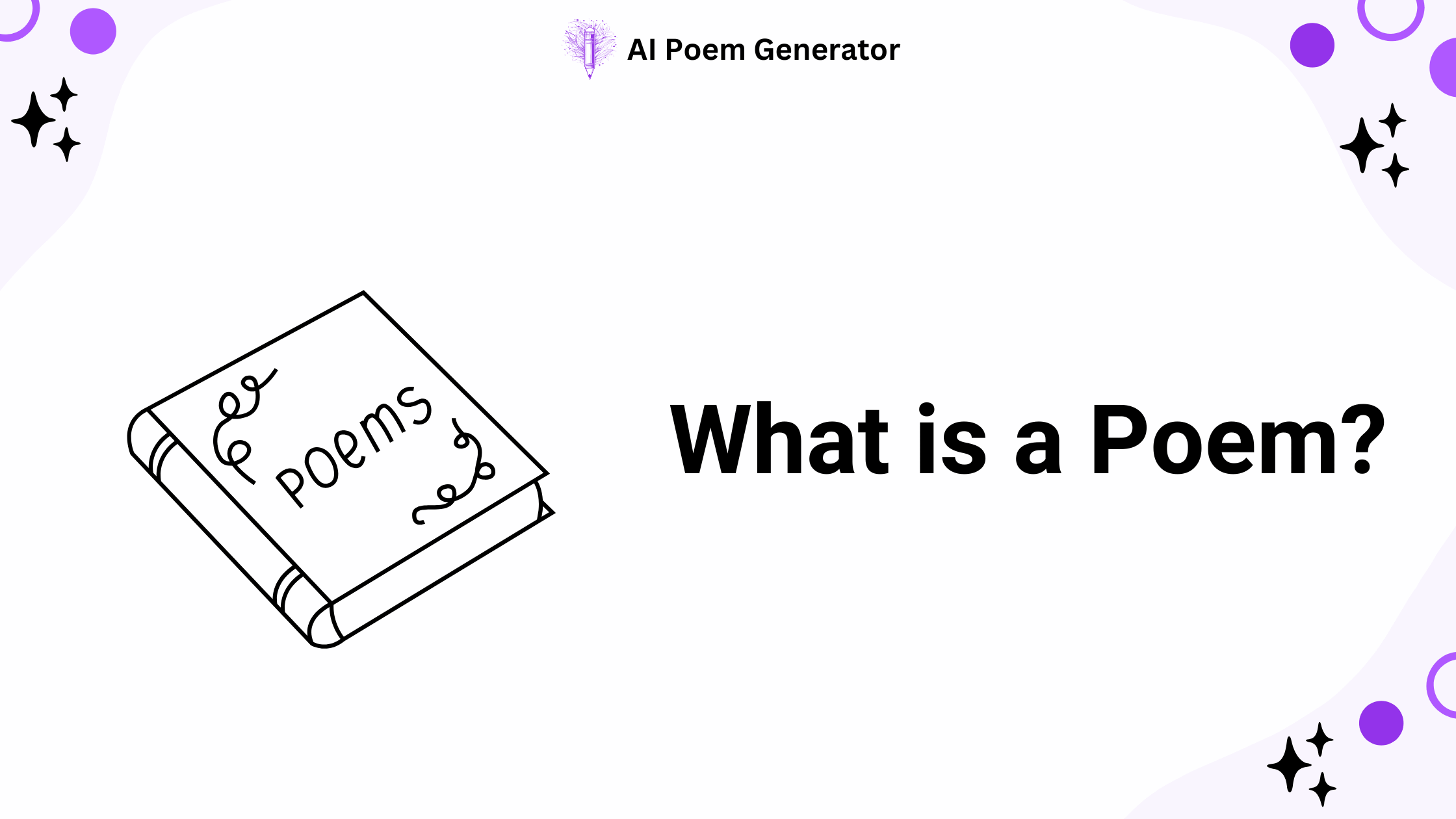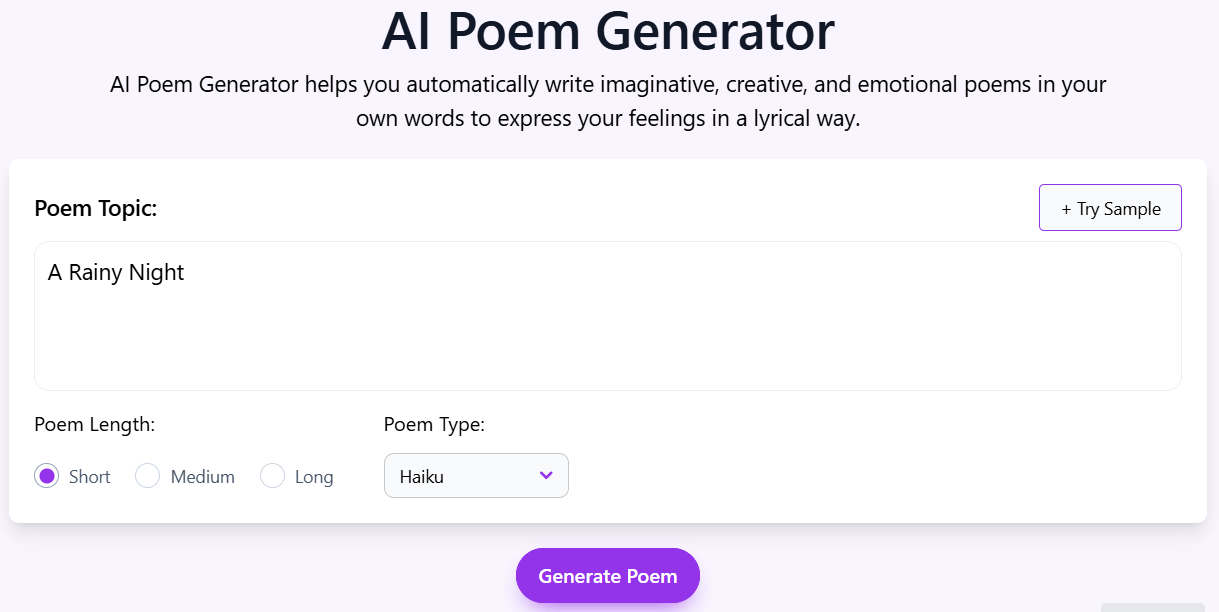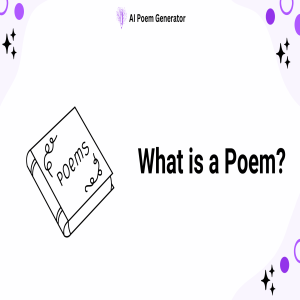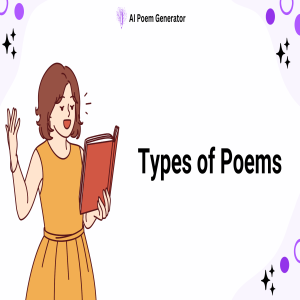What is a Poem?

28 Mar, 2025
A poem is a form of literary expression that uses rhymes, imagery, personification, and other means to convey an idea or thought. It is structured differently, or not at all, as in the case of free verses (more on that later.)
Any poetry revolves around a central theme but can diverge to other concepts or thoughts. One thing that remains certain is that poetry is an art that requires the utmost focus, skill, and time to master.
That said, nowadays, many online tools and resources can help with crafting your verses. Think of them as augmenting your existing writing skillset but not replacing them entirely.
This post explores the definitions, types, and examples of poems to comprehensively answer the question: “What is a Poem?” We will also see how online tools can help in writing poems to help streamline your ideas to perfection. So, let’s get started.
Definition of Poem
As hinted earlier, at its very core, poems are pieces of art, written to evoke emotions and imaginative experiences. They follow a rhyme structure, rhythm, and a deep symbolic meaning.
Historically, poems have been used to spark feelings of patriotism (see the works of André de Chénier: The Voice of Resilience during the French Revolution.) It was also used to promote sociopolitical or religious agendas and serve purposes far beyond.
Poems can also tell tales of love, passion, and experiences, or explain intricate concepts through powerful words. Take a look at this poem below for a better idea of how poems should sound like.
The woods are lovely, dark and deep,
But I have promises to keep,
And miles to go before I sleep,
And miles to go before I sleep.
Robert Frost’s Lyrical Poem ‘Stopping by Woods on a Snowy Evening.’
Although poems should utilize a wide range of poetic devices to draw the attention of readers, there can be many other ways as well to stand apart from others.
Differences Between Poems and Prose
Before we move on to the types of poems and their examples, we should distinguish between poems and prose to solidify our understanding of what is a poem.
Prose is a form of writing representing conversational language: how we speak in real life. These include essays, novels, etc., that may elaborate on ideas and be lengthy (in general.)
Meanwhile, poems are more artistic and emotional with the use of concise language and a rhyme scheme/structure to convey ideas to the reader. Poems also have a sense of musicality and strong use of figurative connotations like similes and metaphors.
The prose is more literal as it conveys thoughts more directly and straightforwardly. Whereas poems can have underlying meanings to words: hidden thoughts that the author leaves for the readers to explore beyond what’s written.
Poems and Prose form the basis of the English language and literature and shall be studied and learned completely separately for the reasons we discussed earlier.
Types of Poems
After learning the differences between prose and poems, it is time that we learned about some of the most common types of poems that exist today.
1) Sonnet
Sonnets are 14-line poems that are written on a specific rhyme scheme or meter but are mainly found in the form of iambic pentameter.
There is further bifurcation in the types of Sonnets that exist today in English literature. For instance, the Shakespearean Sonnet has three 4-line stanzas (or lines) and a final couplet with 2-line stanzas each.
While the Petrarchan Sonnet follows the same 14-line rule as the Sonnets in general but is divided into an octave (8 lines) and a sestet (6 lines).
To understand this type of poem more comprehensively, take a look at this example below.
“An Eerie Feeling”
The air hangs still, a heavy, breathless shroud,
No rustle stirs the leaves upon the tree.
The sun is veiled, a pale and sickly cloud,
And silence reigns, unnervingly.
A prickling sense upon the skin takes hold,
A whisper brushes past, unheard, unseen.
The story whispers, yet remains untold,
Of something ancient, lurking in between.
A vacant gaze from windows, dark and deep,
A shadowed figure at the garden gate,
My heart begins a frantic, hurried leap,
As dread constricts, and seals my destined fate.
The eerie feeling claws, a chilling blight,
And steals the day and swallows up the light.
Notice that the poem follows a Shakespearean Sonnet’s rhyming scheme: ABABCDCDEFEFGG. It has a nice flow to it, gauging the readers right into the author’s world.
2) Haiku
Haiku first emerged in 17th-century Japan as a way to express nature, seasons, and other types of observational and introspective phenomena. Haiku poems are generally written in a 5-7-5 structure of 3 lines.
This means that the first line should be 5 syllables, the second 7 syllables, and so on. Take a look at this example below for more perspective.
“A Rainy Night”
Dark clouds weep softly, (5)
Streetlights blur in silver rain, (7)
World sighs, hushed and still. (5)
Are you curious how we are coming up with so many poem examples? That’s because we use AI Poem Generator for help.
Input your slightest of ideas of the theme you want to follow in your poetry and the poem generator can do the rest of the job in seconds!

This is the example that we showed you earlier. Notice that there are other options to customize your poems, like the poem length, type, etc. Plus, the interface is easy to understand and operate for your convenience.
Okay, back to Haikus. At this point, you might’ve noticed that Haikus don’t need a rhyme to carry on. They simply make strong use of simple, but powerful imagery (e.g., Streetlights blur.)
These strong sensations of human senses (touch, smell, hearing, sight, and taste) tend to perform much better than bland words stuck in a structure.
3) Free Verse
As the name suggests, Free Verse poetries do not need to follow a specific rhyme scheme or structure to convey thoughts.
They are a pure and raw form of poems that can be used to teach young students about poems and this type of art expression.
“Working Long Hours”
The clock face blurs, a hazy moon.
Another email screams for attention,
a siren song in the digital sea.
Coffee, cold now, a bitter promise
of sustained alertness, a lie repeated
too many times tonight.
Back cracks, shoulders ache, eyes burn.
The fluorescent hum, a constant drone,
a soundtrack to the grind.
Outside, the world sleeps, dreams blossom.
Here, only spreadsheets bloom, charts rise,
and the relentless push forward.
For what?
For another day.
In this example, we can see that the writer isn’t too concerned about the laws and physics of poetry but expressing their feelings and emotions clearly to the reader.
This is a reason why we like Free Verses because they uncover a lot of that heart that is otherwise buried deep down in some fancy words or literature complexities. Hence, they can be the perfect choice for beginners to learn to write poetry.
4) Lyrical
The poem we covered at the start of this post from Robert Frost was, indeed, a Lyrical poem. These don’t have to obey a singular structure type to convey the emotions of the author and are often written in the ‘I’ form.
“Joe: The Grumpy Old Man”
A weathered face, a sun-scorched hue,
Joe shuffles on, with spirit askew.
A growl escapes, a muttered sigh,
As youthful laughter bubbles nigh.
He sees the world with jaded eyes,
Where innocence so quickly dies.
A rusting gate, a creaking door,
He's seen this all a thousand times before.
Yet in his gaze, a flicker sleeps,
A buried warmth that sorrow keeps.
Perhaps a kindness, lost and deep,
That even grumpy Joe would weep.
Lyrical poems often have that musical quality to them that makes a person sway to the beats verse after verse. These types of poems are great for teaching children about rhyming schemes and having some fun in the process!
5) Limerick
The final type of poem we will cover today is a Limerick. These follow the AABBA rhyme scheme and are often written in a funny and playful manner. They are always five lines long and have a humorous tone to cheer up the readers with joy.
“Finding My Phone”
My phone, oh where could it be? (A)
Was it under the couch, next to me? (A)
A frantic search round, (B)
No helpful sound, (B)
Then found in my back pocket, glee! (A)
A common characteristic of Limericks is that they have a bouncy rhythm with a song-type feeling to them. That is the reason why Limericks are commonly found in the entertainment industry and are used to gauge audiences.
Final Words
A poem is a unique form of literary expression that uses various poetic devices such as rhyme, imagery, and structure to convey emotions and ideas about life, nature, and other experiences.
Unlike prose, poems utilize concise language and often possess underlying meanings that readers are prompted to uncover themselves.
When it comes to writing poems, modern resources and AI tools like the AI Poem Generator are highly helpful. They can make crafting poetry more accessible to nonwriters, enhancing their skills without replacing their creativity.

